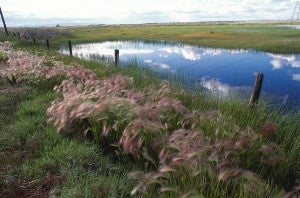How agriculture’s resilience to climate change benefits us all

Traditionally, governments haven’t factored farms and ranches into their climate mitigation and adaptation planning. Instead, the focus has mostly been on protecting urban communities. But that is all changing. At the National Adaptation Forum earlier this month in St. Louis, agriculture was top-of-mind in discussions about reducing emissions and building resilience to climate change.
That’s because in order to protect people, 81 percent of whom live in urban areas, we’ll need to protect what’s around where they live, too. It’s largely rural areas, like the farming town of 1,100 people where I grew up, whose working lands and farms provide valuable services to urban areas. These services include food security, flood and drought protection, recreation and water storage. Agriculture can also play (and is already playing) a big role in reducing greenhouse gas emissions.
The more resilient we can make agriculture, the better off we’ll all be.
Fortunately, pilot programs are already underway that demonstrate the value of investing in agricultural mitigation and adaptation programs. Plus, these programs are proving that we can tackle climate change through agriculture while maintaining or increasing yields, and offering additional income for farmers.
Green infrastructure

Many people think that using man-made structures, like higher seawalls and raised bridges or roads, is the best and least expensive way to shut out the impacts of climate change.
Increasingly, we have found that investing in green infrastructure – such as strategically managed wetlands, buffers, trees, and grasses – provides more bang for your adaptation buck. Features such as healthy wetlands and buffers installed on working lands can go a long way towards recharging groundwater, reducing erosion that can cause flooding downstream, protecting important species, and increasing resiliency to severe weather.
In the Mississippi River Delta, there is a voluntary program that incentivizes landowners and farmers to restore wetlands on their property, since there is proof that restoring wetlands can reduce greenhouse gas emissions and help buffer coastal populations from storm surges. In California, there is a carbon protocol currently under review that would incentivize wetland restoration to sequester carbon, protect against floods, and improve habitat.
Compost on the range
Rangeland ecosystems, which cover approximately one-third of land in the U.S. and half of the land in California, have enormous potential to reduce greenhouse gas emissions.
The American Carbon Registry recently announced a carbon accounting method that allows ranchers who apply compost to their fields to earn credits that can be sold in voluntary carbon markets. That’s because applying compost to grazed grasslands helps the lands adapt to drought conditions, increases the soil’s water holding capacity, and reduces greenhouse gas emissions. Not only does the compost stimulate plant growth, which increases forage for cattle, but it also improves the soil’s ability to store carbon.
If ranchers applied compost to just 5 percent of California’s rangelands, emissions would be reduced by 28 million metric tons, the equivalent of the annual emissions from all the homes in the state.
Income for rice and corn farmers
The California Air Resources Board is in the final stages of approval for a protocol that would allow rice farmers to generate carbon credits by reducing methane emissions while sustaining production and providing critical wetland habitat for migratory birds. When approved, this will be the first crop-based protocol, setting the stage for other agricultural protocols in the near future.
Gaining momentum
Earlier this spring, the U.S. Department of Agriculture (USDA) launched a new program to reduce emissions from agriculture, improve resiliency, and work with farmers and ranchers to scale up sustainable agriculture. This initiative will promote voluntary and incentive-based approaches as well as climate-smart agriculture techniques.
And just last year, the USDA launched its Climate Hubs program that helps farmers connect to adaptation and mitigation resources. The program is divided by region, so farmers and ranchers across the U.S. can get the most relevant information for their geography and soil type.
From New York to California, growers are changing their management practices to make their farms more resilient. Still, more financial resources are needed. It’s time for local governments to invest in the adaptation of rural areas and working lands. This will benefit us all, wherever we call home.













3 Comments
Nice job, Sarah. Programs you highlighted offer hope, yet the strong majority of those managing our agricultural lands are not engaged or are only marginally engaged with these efforts. Some farmers and ranchers are fully engaged and are demonstrating that growing green can be profitable as well as environmentally friendly. It is proof that it can be done and it is inspirational. However, we suffer from selected government policies that deliver negative incentives for diversification as well as ‘green’ production methods. In fact, these programs, such as crop and revenue insurance programs, arguably dominate farmer driven incentives in major parts of this country. To make real progress we must have incentives across programs and policies are moving us in a common FAVORABLE direction. Currently they are not.
Thanks, Rick, for your thoughtful comment. I agree that we need to align incentives for farmers to get more movement in the right direction. My team at EDF looks at policy, economic, and social incentives for our grower partners and recognizes that we won’t be successful without all three. As I say in my blog, we are gaining momentum, as farmers and ranchers learn more about their systems with improved information and tools, like your Iowa Daily Erosion Project (http://wepp.mesonet.agron.iastate.edu/). It is my experience that sharing the right technology, along with the success stories we are seeing, gets conversations going to incite the positive change we all want to see.
EXCELENTE, Fantastic